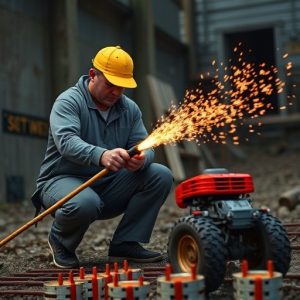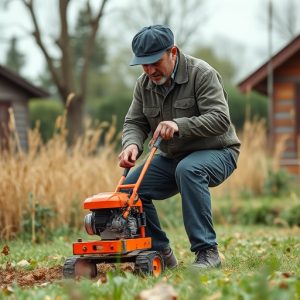Mastering the Kubotan Art: An Insider’s Guide to Self-Defense Techniques
The Kubotan is a specialized self-defense tool derived from Eskrima traditions, offering users an e…….
The Kubotan is a specialized self-defense tool derived from Eskrima traditions, offering users an extended reach and enhanced striking power. Its effectiveness as a self-defense instrument is contingent upon mastery of its use, which requires dedicated training beyond mere familiarity. The Kubotan's design—a short, robust stick with a blunt end and ridged grip for secure handling—allows for a variety of applications, including pressure point application, control over an attacker's limbs, and potent strikes. Proficiency in using the Kubotan involves understanding its mechanics, such as disarming techniques, threat mitigation, and personal safety strategies, without resorting to lethal force. It is a versatile tool for self-defense that can be inconspicuously carried on a keychain and is integral to Eskrima, Arnis, and Kali martial arts. Training should be undertaken under the guidance of seasoned practitioners to ensure proper technique and safety protocols. Mastery of the Kubotan's stance, grip, and integration into defensive techniques are essential for its effective use. Advanced techniques include disarming strategies and pressure point strikes, which must be practiced consistently to develop muscle memory and quick reactions. The Kubotan can also be used in groundwork and flow drills, requiring a deep understanding of body mechanics, leverage, and control. Regular practice of these techniques is crucial for martial artists seeking to enhance their self-defense capabilities with this unique tool, making them adept at handling various confrontation scenarios effectively. How to use a Kubotan effectively is a critical skill set for those interested in self-defense within the context of martial arts.
Exploring the dynamic world of self-defense, this article delves into the intricacies of the Kubotan—a versatile self-defense tool that has gained prominence among martial artists and civilians alike. Originating from the teachings of Master Anthony Pahl, the Kubotan’s compact design offers a tactical advantage in close-quarters combat. We will dissect its components and material selection, which are crucial for its effectiveness. Furthermore, we will guide you through mastering the optimal stance to enhance your technique execution. With a focus on practical application, we will outline essential Kubotan techniques suitable for self-defense scenarios, including step-by-step instructions for novices. For seasoned practitioners, the article advances to cover sophisticated maneuvers that integrate strikes with groundwork and flow drills, offering a comprehensive understanding of how to use a Kubotan effectively.
Understanding the Kubotan: An Overview of Its Origins and Use in Self-Defense
The Kubotan is a self-defense tool that has garnered attention within martial arts communities for its versatility and effectiveness in a variety of combat situations. Originating from the Filipino Martial Art of Eskrima, also known as Kali or Arnis, the Kubotan’s design is simple yet profoundly impactful. It consists of a short, thick stick with a blunt end, often capped with a hard material like aluminum or plastic, and is typically used in conjunction with an assortment of hand positions to maximize its defensive potential. Understanding how to use a Kubotan goes beyond mere familiarity with the device; it involves integrating it into one’s self-defense repertoire through practice and training. The Kubotan can extend the reach of one’s strikes, deliver powerful pressure point techniques, and provide a means to control an attacker’s limbs. Its use in self-defense is predicated on leveraging its size and shape to disarm opponents, neutralize threats, and protect oneself without resorting to lethal force, making it a valuable tool for personal safety. Training in the Kubotan’s application requires dedication and skill development, as it involves intricate movements and precise targeting. Martial artists interested in incorporating the Kubotan into their training should seek instruction from experienced practitioners who can guide them through the proper techniques and safety considerations involved with its use.
The Anatomy of a Kubotan: Components, Materials, and Design Considerations
The Kubotan is a versatile self-defense tool that has gained popularity in martial arts, particularly within the styles of Eskrima, Arnis, and Kali. This tactical instrument is designed to extend the range and effectiveness of hand strikes. It typically measures between 6 to 9 inches in length and is constructed from durable materials such as aluminum, wood, or titanium, chosen for their balance, weight, and resilience. The Kubotan’s anatomy consists of a central spine that runs the length of the device, providing a sturdy structure, and a tapered tip that allows for targeted pressure points strikes. The handle is often ridged or grooved to accommodate the user’s grip, enhancing control and preventing slippage during intense combat scenarios. The design also includes a keychain ring at one end, enabling users to carry it discreetly on their keys or bag. Understanding how to use a Kubotan effectively involves mastering its various applications, from striking techniques to locking mechanisms that can incapacitate an attacker. Users must familiarize themselves with the proper grip and stance to maximize the tool’s potential in self-defense situations. Additionally, the Kubotan’s design facilitates practice of pressure point strikes, which can be a critical component in neutralizing a threat without causing permanent harm. Proper training is essential to utilize this weapon safely and effectively, ensuring that users can defend themselves with confidence and skill.
Mastering the Kubotan Stance: Positioning for Effective Techniques
Mastering the Kubotan stance is a critical aspect for those seeking to effectively wield this self-defense tool. The Kubotan, a short, dense stick, is designed to extend the range and impact of hand techniques. To properly position oneself for optimal use of the Kubotan, one must first understand the fundamentals of stance and body alignment. A stable yet mobile foundation is key; begin by standing with your feet shoulder-width apart, ensuring that your dominant leg is slightly forward for balance. Keep your knees soft to maintain flexibility and ready your body to shift quickly should the situation demand it. Your hands, whether holding the Kubotan or in ready position, should be relaxed yet prepared, with elbows close to the body to protect vital organs. When gripping the Kubotan, adopt a firm yet non-restrictive hold that allows for fluid movement. The angle at which you hold the Kubotan is crucial; it should not be perpendicular to your opponent but rather angled in such a way that the end of the tool is an extension of your arm, providing both reach and protection.
Once the stance is established, the focus shifts to integrating the Kubotan into various techniques. Practicing how to use a Kubotan within this stable stance will enhance the effectiveness of strikes, blocks, and control maneuvers. For example, when executing a strike, the Kubotan extends your reach, allowing you to maintain a safe distance from an attacker. The stance should facilitate swift, targeted movements, ensuring each technique is delivered with precision and power. It’s also important to practice defensive moves, such as parrying and deflecting attacks while maintaining your stance. This will help you remain centered and balanced, ready to respond to any threat with a series of controlled, effective Kubotan techniques. Regular practice and drilling these movements will solidify the stance as a natural part of your self-defense repertoire, enabling you to use the Kubotan effectively in a variety of situations.
Essential Kubotan Techniques for Self-Defense: A Step-by-Step Guide
The Kubotan is a self-defense tool that has gained popularity among martial artists and civilians alike due to its effectiveness in various combat scenarios. To master the use of a Kubotan for self-defense, it’s crucial to understand and practice essential techniques. One of the fundamental methods involves gripping the Kubotan correctly; this allows for effective control and execution of techniques. The first step is to hold the Kubotan near the tip with a firm yet flexible grip, which provides leverage for strikes while maintaining agility. From this position, practitioners can learn to deliver precise and powerful strikes to vulnerable areas of an attacker, such as the hands, elbows, knees, and shins.
Advanced Kubotan techniques incorporate the tool into disarming and defense maneuvers. For instance, a technique known as “key lock” can be used to immobilize an opponent’s hand, while another method, the “hambone strike,” involves using the edge of the Kubotan to deliver a powerful blow to an attacker’s bones, which are more susceptible to fracture than softer tissues. These advanced techniques require practice and precision but can be life-saving in a self-defense situation. To effectively use a Kubotan, one must integrate these methods into regular training, ensuring familiarity with the tool’s applications. Regular drills and sparring will enhance reaction times and muscle memory, making it second nature to deploy the Kubotan when faced with an aggressive threat. Knowledge of how to use a Kubotan extends beyond mere technique; it involves understanding its role in personal protection and the commitment to practice these skills consistently.
Advanced Kubotan Maneuvers: Combining Strikes with Groundwork and Flow Drills
When integrating the Kubotan into groundwork and flow drills, practitioners can elevate their martial arts skills to an advanced level. The Kubotan, a short, rigid stick designed for self-defense, offers users a tool to extend the reach of their strikes and deliver precise pressure points techniques. Mastery of how to use a Kubotan effectively on the ground requires a deep understanding of body mechanics, leverage, and control. Practitioners must learn to transition smoothly from standing strikes to applying the Kubotan in ground fighting scenarios. This involves using the tool to maintain space, control an opponent’s limbs, and set up joint locks or restraints while maintaining a defensive posture.
Flow drills with the Kubotan are essential for developing fluidity and coordination when incorporating this weapon into one’s martial arts repertoire. These drills typically start from a neutral stance and simulate various combat situations, allowing practitioners to practice transitioning between techniques seamlessly. The flow of movements becomes second nature with repetition, ensuring that when faced with an actual confrontation, the user can respond with precision and confidence. Advanced students are encouraged to explore different angles of attack and combinations that exploit vulnerabilities in their opponent’s guard. By regularly practicing these drills, martial artists can refine their Kubotan skills, making their self-defense capabilities robust and adaptable to a wide range of situations.


